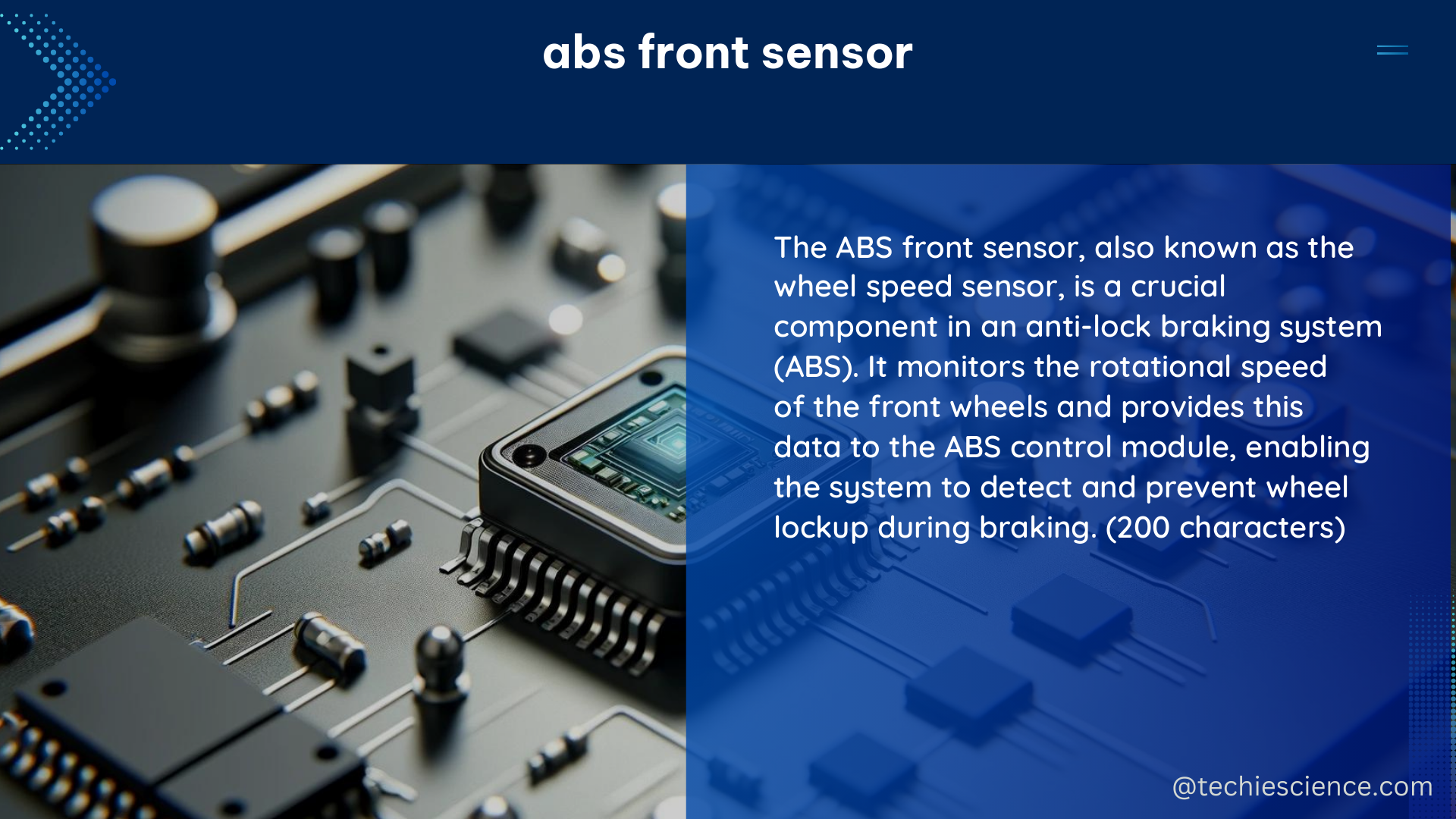The ABS (Anti-lock Braking System) front sensor is a critical component in modern vehicles, responsible for maintaining vehicle stability and control during hard braking. This sensor works by detecting the rotation speed of the front wheels, providing crucial data to the ABS control module to regulate the braking force and prevent wheel lockup. In this comprehensive guide, we’ll delve into the technical specifications, testing procedures, and maintenance considerations for the ABS front sensor, equipping you with the knowledge to ensure optimal performance and safety.
Understanding the ABS Front Sensor
The ABS front sensor is typically a small, cylindrical component mounted near the front wheels, either on the brake caliper, wheel hub, or suspension component. This sensor generates an alternating voltage in response to the rotation of the wheel, with the frequency and amplitude of the voltage directly related to the wheel speed.
Technical Specifications
- Voltage Output: The ABS front sensor typically generates a voltage output ranging from a few millivolts to several volts, depending on the specific design and configuration of the sensor.
- Frequency: The frequency of the sensor’s output voltage is directly proportional to the wheel speed, with higher frequencies indicating faster wheel rotation.
- Sensor Type: ABS front sensors can be either active or passive. Active sensors require a separate power supply, while passive sensors rely on the magnetic field of the wheel to generate a signal.
- Physical Dimensions: The ABS front sensor is a compact component, typically measuring between 10-30 mm in length and 5-15 mm in diameter, depending on the vehicle model and manufacturer.
- Mounting Location: The sensor is strategically positioned near the front wheels, often on the brake caliper, wheel hub, or suspension component, to accurately detect wheel rotation.
Testing the ABS Front Sensor

Proper testing of the ABS front sensor is crucial to ensure its proper functioning and identify any potential issues. Here’s a step-by-step guide to testing the sensor:
- Sensor Connection Inspection: Begin by visually inspecting the sensor connection, ensuring it is secure and free from any damage or corrosion.
- Voltage Test: Using a multimeter, measure the voltage coming to the sensor. This voltage should be within the range specified by the vehicle manufacturer and should only be present when the vehicle is turned on.
- Sensor Output Test: Disconnect the sensor and use an LED tester or oscilloscope to check the sensor’s output signal. Look for a clean, consistent waveform that corresponds to the wheel’s rotation speed.
- Resistance Test: Measure the resistance of the sensor using a multimeter. The resistance should fall within the range specified by the vehicle manufacturer, typically between 1 to 2 kΩ.
- Sensor Replacement: If the sensor is found to be faulty, it will need to be replaced. Ensure that the replacement sensor is compatible with the vehicle and follow the manufacturer’s installation instructions carefully.
Maintaining the ABS Front Sensor
To ensure the long-term reliability and performance of the ABS front sensor, regular maintenance and inspection are essential. Here are some key maintenance considerations:
- Sensor Cleaning: Periodically clean the sensor and its mounting area to remove any accumulated dirt, debris, or corrosion, which can interfere with the sensor’s operation.
- Wiring Harness Inspection: Regularly inspect the sensor’s wiring harness for any signs of damage, such as fraying, cracking, or loose connections, and address any issues promptly.
- Sensor Replacement Interval: While the ABS front sensor is generally a durable component, it’s recommended to replace it as per the vehicle manufacturer’s recommended service interval, typically every 60,000 to 100,000 miles (96,000 to 160,000 km).
- Sensor Compatibility: When replacing the ABS front sensor, ensure that the new component is compatible with the specific make, model, and year of the vehicle, as sensor specifications can vary between different models.
Conclusion
The ABS front sensor is a crucial component in modern vehicles, playing a vital role in maintaining braking performance and vehicle stability. By understanding the technical specifications, testing procedures, and maintenance requirements of this sensor, you can ensure that your vehicle’s braking system is operating at its best, providing you with the confidence and safety you need on the road.
References:
- How to test front ABS sensor IS250 – Lexus Forum Discussion: https://www.clublexus.com/forums/is-2nd-gen-2006-2013/914154-how-to-test-front-abs-sensor-is250.html
- How to get ABS LIVE DATA from your car in 2 minutes – YouTube: https://www.youtube.com/watch?v=bEXaEL4efKA
- Check and change ABS and wheel speed sensors | HELLA: https://www.hella.com/techworld/us/Technical/Sensors-and-actuators/Check-change-ABS-sensor-4074/

The lambdageeks.com Core SME Team is a group of experienced subject matter experts from diverse scientific and technical fields including Physics, Chemistry, Technology,Electronics & Electrical Engineering, Automotive, Mechanical Engineering. Our team collaborates to create high-quality, well-researched articles on a wide range of science and technology topics for the lambdageeks.com website.
All Our Senior SME are having more than 7 Years of experience in the respective fields . They are either Working Industry Professionals or assocaited With different Universities. Refer Our Authors Page to get to know About our Core SMEs.